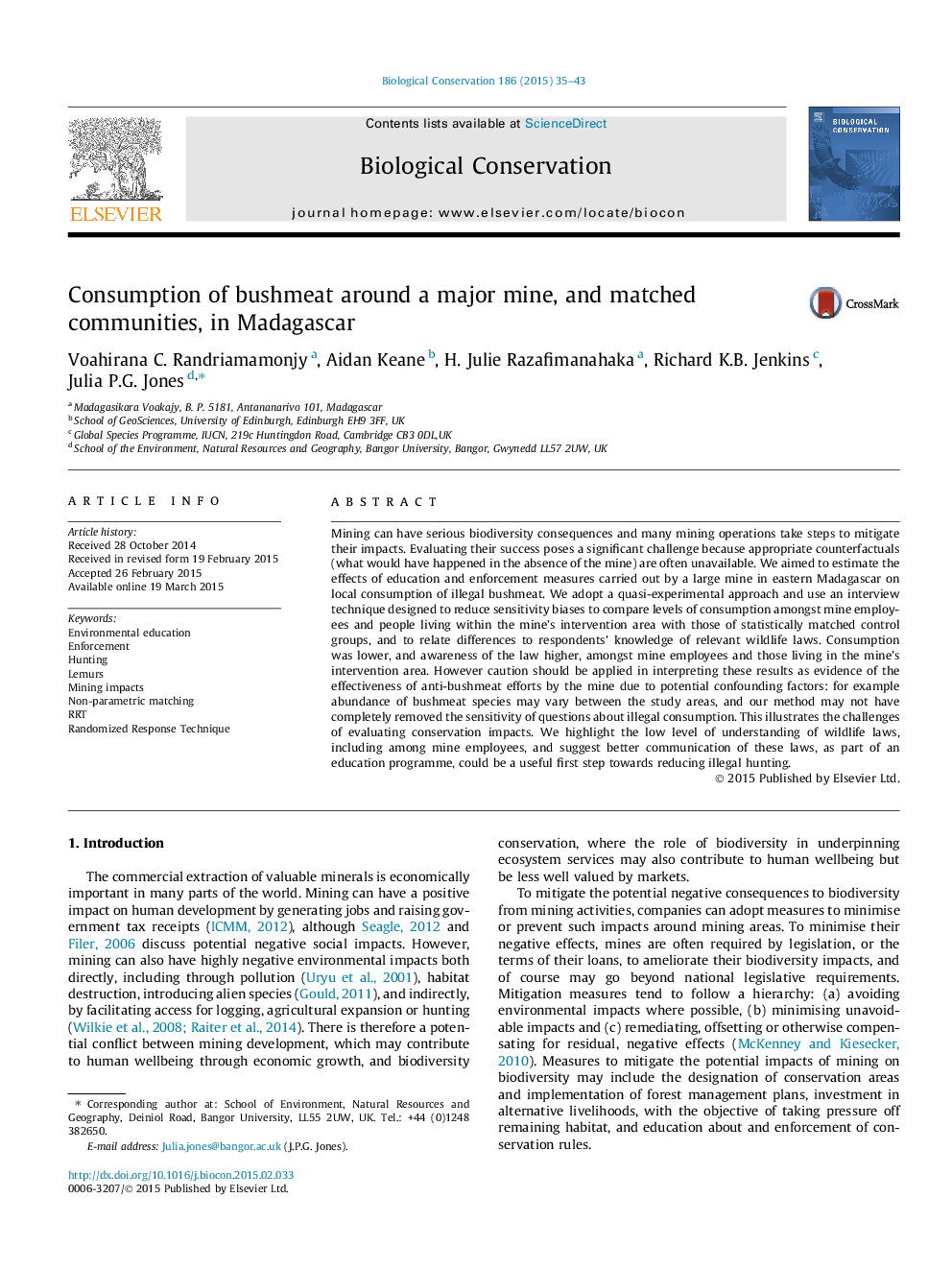| کد مقاله | کد نشریه | سال انتشار | مقاله انگلیسی | نسخه تمام متن |
|---|---|---|---|---|
| 6299663 | 1617915 | 2015 | 9 صفحه PDF | دانلود رایگان |
عنوان انگلیسی مقاله ISI
Consumption of bushmeat around a major mine, and matched communities, in Madagascar
ترجمه فارسی عنوان
مصرف مکمل بوته در اطراف یک معدن عمده و جوامع همسان در ماداگاسکار
دانلود مقاله + سفارش ترجمه
دانلود مقاله ISI انگلیسی
رایگان برای ایرانیان
کلمات کلیدی
ترجمه چکیده
معادن می توانند عواقب تنوع زیستی جدی داشته باشند و بسیاری از عملیات استخراج معادن گام هایی برای کاهش اثرات آنها می دهند. ارزیابی موفقیت آنها یک چالش مهم است، زیرا متضادها مناسب (که در غیاب معدن اتفاق افتاده است) اغلب در دسترس نیستند. ما با هدف برآورد اثرات آموزش و پرورش و اقدامات اجرایی انجام شده توسط یک معدن بزرگ در شرق ماداگاسکار در مصرف محلی غیرقانونی ماهی قزل آلا. ما یک رویکرد شبه آزمایشی را اتخاذ می کنیم و از روش مصاحبه ای استفاده می کنیم که برای کاهش تعصب های حساسیتی برای مقایسه میزان مصرف در میان کارکنان معدن و افرادی که در منطقه مداخله معدن با گروه های کنترل از لحاظ آماری همسان هستند مقایسه می شود و تفاوت ها را نسبت به دانش پاسخ دهندگان قوانین حیات وحش مربوطه. مصرف کمتر و آگاهی بیشتر از قانون در میان کارکنان معدن و کسانی که در منطقه مداخله معدن زندگی می کنند، بالاتر است. با این وجود، باید توجه داشته باشید که این نتایج به عنوان شواهدی از اثربخشی تلاش های ضد بسمن توسط معدن به دلیل عوامل مخرب احتمالی باید مورد توجه قرار گیرد: به عنوان مثال فراوانی گونه های بوته می تواند بین مناطق مطالعه متفاوت باشد و روش ما ممکن است به طور کامل حساسیت سوالات در مورد مصرف غیرقانونی. این چالشهای ارزیابی اثرات حفاظت را نشان می دهد. ما سطح پایین درک قوانین حیات وحش، از جمله در میان کارکنان معدن را برجسته می کنیم و بیان می کنیم که ارتباط بهتر این قوانین به عنوان بخشی از برنامه آموزشی، می تواند اولین گام مفید برای کاهش شکار غیر قانونی باشد.
موضوعات مرتبط
علوم زیستی و بیوفناوری
علوم کشاورزی و بیولوژیک
بوم شناسی، تکامل، رفتار و سامانه شناسی
چکیده انگلیسی
Mining can have serious biodiversity consequences and many mining operations take steps to mitigate their impacts. Evaluating their success poses a significant challenge because appropriate counterfactuals (what would have happened in the absence of the mine) are often unavailable. We aimed to estimate the effects of education and enforcement measures carried out by a large mine in eastern Madagascar on local consumption of illegal bushmeat. We adopt a quasi-experimental approach and use an interview technique designed to reduce sensitivity biases to compare levels of consumption amongst mine employees and people living within the mine's intervention area with those of statistically matched control groups, and to relate differences to respondents' knowledge of relevant wildlife laws. Consumption was lower, and awareness of the law higher, amongst mine employees and those living in the mine's intervention area. However caution should be applied in interpreting these results as evidence of the effectiveness of anti-bushmeat efforts by the mine due to potential confounding factors: for example abundance of bushmeat species may vary between the study areas, and our method may not have completely removed the sensitivity of questions about illegal consumption. This illustrates the challenges of evaluating conservation impacts. We highlight the low level of understanding of wildlife laws, including among mine employees, and suggest better communication of these laws, as part of an education programme, could be a useful first step towards reducing illegal hunting.
ناشر
Database: Elsevier - ScienceDirect (ساینس دایرکت)
Journal: Biological Conservation - Volume 186, June 2015, Pages 35-43
Journal: Biological Conservation - Volume 186, June 2015, Pages 35-43
نویسندگان
Voahirana C. Randriamamonjy, Aidan Keane, H. Julie Razafimanahaka, Richard K.B. Jenkins, Julia P.G. Jones,
